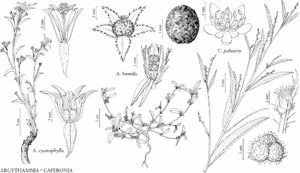Difference between revisions of "Argythamnia cyanophylla"
Bull. Torrey Bot. Club 80: 423. 1953.
FNA>Volume Importer |
imported>Volume Importer |
||
| (5 intermediate revisions by 2 users not shown) | |||
| Line 10: | Line 10: | ||
|special_status={{Treatment/ID/Special_status | |special_status={{Treatment/ID/Special_status | ||
|code=F | |code=F | ||
| − | |label= | + | |label=Illustrated |
}}{{Treatment/ID/Special_status | }}{{Treatment/ID/Special_status | ||
|code=E | |code=E | ||
|label=Endemic | |label=Endemic | ||
}} | }} | ||
| − | |basionyms={{Treatment/ID/ | + | |basionyms={{Treatment/ID/Basionym |
|name=Ditaxis cyanophylla | |name=Ditaxis cyanophylla | ||
|authority=Wooton & Standley | |authority=Wooton & Standley | ||
| + | |rank=species | ||
| + | |publication_title=Bull. Torrey Bot. Club | ||
| + | |publication_place=36: 106. 1909 | ||
}} | }} | ||
|synonyms={{Treatment/ID/Synonym | |synonyms={{Treatment/ID/Synonym | ||
|name=D. diversiflora | |name=D. diversiflora | ||
|authority=Clokey | |authority=Clokey | ||
| + | |rank=species | ||
}} | }} | ||
|hierarchy=Euphorbiaceae;Argythamnia;Argythamnia cyanophylla | |hierarchy=Euphorbiaceae;Argythamnia;Argythamnia cyanophylla | ||
| Line 46: | Line 50: | ||
-->{{#Taxon: | -->{{#Taxon: | ||
name=Argythamnia cyanophylla | name=Argythamnia cyanophylla | ||
| − | |||
|authority=(Wooton & Standley) J. W. Ingram | |authority=(Wooton & Standley) J. W. Ingram | ||
|rank=species | |rank=species | ||
| Line 60: | Line 63: | ||
|publication title=Bull. Torrey Bot. Club | |publication title=Bull. Torrey Bot. Club | ||
|publication year=1953 | |publication year=1953 | ||
| − | |special status= | + | |special status=Illustrated;Endemic |
| − | |source xml=https:// | + | |source xml=https://bitbucket.org/aafc-mbb/fna-data-curation/src/2e0870ddd59836b60bcf96646a41e87ea5a5943a/coarse_grained_fna_xml/V12/V12_698.xml |
|genus=Argythamnia | |genus=Argythamnia | ||
|species=Argythamnia cyanophylla | |species=Argythamnia cyanophylla | ||
Latest revision as of 19:17, 5 November 2020
Herbs, perennial, monoecious, to 2.5 dm. Stems erect, sparsely hairy, hairs malpighiaceous. Leaves: stipules apparently persistent, punctiform, minute, margins glandular; petiole absent; blade elliptic, obovate, or linear, 1–5 × 0.5–2.2 cm, margins entire, without glands, surfaces sparsely hairy, hairs malpighiaceous. Inflorescences unisexual or bisexual, to 4 cm; bracts ovate to lanceolate, to 1.5 mm, margins without glands. Flowers without pink dye when wetted. Staminate flowers: sepals lanceolate, 3.5–7 × 1–1.3 mm; petals spatulate to obovate, 3–5 × 1.5 mm, adnate to androphore; nectary glands elliptic, 0.3 × 0.2 mm, adnate to androphore, glabrous; stamens (7–)10, staminodes 0 or rudimentary. Pistillate flowers: sepals lanceolate to ovate, 3.5–7 × 1.5–2.2 mm, without glands; petals 5, obovate to spatulate, 2.8–3.5 × 0.7–2.8 mm; nectary glands obovate, 0.5 × 0.7 mm, glabrous; ovary sericeous; styles 1.6–2 mm, glabrous; stigmas flattened. Capsules 3–5.5 mm, with scattered adpressed malpighiaceous hairs. Seeds 3.5–4 mm, smooth, maculate.
Phenology: Flowering Mar–Jun and Aug–Oct.
Habitat: Scrub, pinyon-juniper woodlands, limestone-derived, rocky soils, damp zones near lakes.
Elevation: 2000–2600 m.
Distribution

Ariz., Nev., N.Mex.
Discussion
Argythamnia cyanophylla is found from southern Nevada across northern Arizona to central New Mexico.
Selected References
None.
